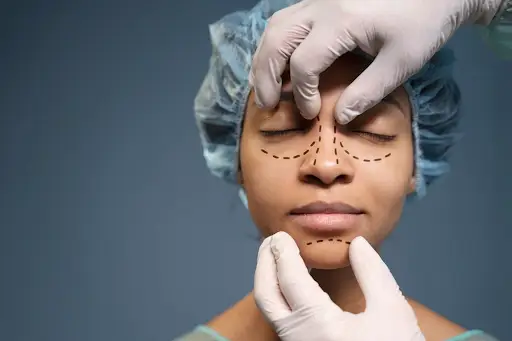Lower Eyelid Surgery: Purpose, Procedure, and Recovery
Author: Nulook ExpertiseReview by: -Do you feel that your lower eyelids look tired or sagging? If so, lower eyelid surgery might be the right solution to restore a youthful and refreshed appearance. This procedure aims to remove excess skin and fat that can accumulate due to aging or genetic factors. In addition to enhancing facial aesthetics, this surgery can also help improve vision if sagging eyelids are obstructing your view.
In this article, we’ll explore the goals, procedure, and recovery process after lower eyelid surgery, helping you understand this step toward a brighter, more confident look.
Read Also: How to Get Rid of Panda Eye Bags: Effective Tricks to Look Fresh
Goals of Lower Eyelid Surgery
Lower eyelid surgery, or blepharoplasty, is a surgical procedure designed to enhance the appearance of the eye area, specifically the lower eyelid. This procedure can address not only aesthetic concerns but also provide functional benefits. Below are the primary goals of lower eyelid surgery:
1. Remove Excess Skin and Fat
As we age, the skin loses its elasticity, and fat may start to protrude, leading to a puffy or baggy appearance. During surgery, the surgeon will remove excess skin and fat, resulting in a more streamlined, youthful look. The outcome is a refreshed and rejuvenated eye area.
2. Improve Aesthetic Appearance
Lower eyelid surgery isn't just about health; it also enhances aesthetics. Many people feel self-conscious about their tired, aged appearance around the eyes. By refining the lower eyelid, you can achieve a more harmonious and attractive facial appearance. The procedure helps balance facial features, giving an overall fresher and more appealing look.
3. Enhance Vision Function
Besides aesthetic improvements, lower eyelid surgery can also boost vision functionality. In some cases, excess skin on the lower eyelid can obstruct your view. By removing this extra skin, the procedure can help widen the field of vision, improving everyday visual clarity. This is particularly beneficial if sagging eyelids are affecting your ability to see properly.
4. Reduce Wrinkles and Fine Lines
The surgery also targets the reduction of wrinkles and fine lines around the eye area. By removing excess skin, the procedure can smooth the appearance of the skin, diminishing the visible signs of aging. This not only enhances physical appearance but also boosts confidence and personal comfort.
Read Also: 4 Things to Avoid After Under-Eye Filler and Its Side Effects
The Lower Eyelid Surgery Procedure
This process involves several stages to ensure optimal results and minimize risks. Below are the main steps in the lower eyelid surgery procedure:
1. Initial Consultation
During this stage, the surgeon will conduct a comprehensive evaluation of your eye and facial condition. The discussion will cover your aesthetic goals, medical history, and any potential risks and benefits of the surgery. The doctor will explain the techniques that will be used and provide guidance on what can be achieved through the procedure. This is an ideal time to ask questions and ensure you feel comfortable before moving forward.
2. Pre-Operative Preparation
After the consultation, the surgeon will provide instructions for pre-operative preparation. This may include stopping the use of certain medications, such as aspirin or blood thinners, which can increase the risk of bleeding. You may also be advised to avoid eating or drinking for a specific period before the surgery. Following these instructions is crucial to ensure the surgery proceeds safely and smoothly.
3. Anesthesia
On the day of the surgery, the next step is administering anesthesia. The procedure can be performed under local anesthesia, which numbs the area around the eyes, or general anesthesia, which will put you to sleep during the surgery. The choice of anesthesia depends on the complexity of the procedure and the surgeon's preference. With the right anesthesia, you’ll be comfortable and pain-free throughout the process.
4. Surgical Procedure
Once anesthesia is administered, the surgeon will begin the lower eyelid surgery. This usually starts with making an incision along the natural crease of the lower eyelid. Through this incision, the surgeon will remove excess skin and fat that cause the puffiness or sagging. If necessary, additional procedures, such as muscle tightening or skin smoothing, may be performed to achieve better results. After all adjustments are made, the incision is carefully stitched to minimize scarring.
5. Recovery Process
After surgery, you will be taken to a recovery room for monitoring by the medical team. It is crucial to follow post-operative care instructions, including keeping the surgical area clean and avoiding activities that could increase the risk of complications. You may experience some swelling, bruising, or discomfort, but these usually subside within a few days. Your doctor will provide guidance on using cold compresses and pain relief medications to help ease discomfort during recovery.
Read Also: 6 Benefits of Under-Eye Fillers: Look Fresher and Brighter
6. Post-Operative Recovery
Lower eyelid surgery is an effective procedure to enhance your appearance and quality of life, especially if you're looking to combat the signs of aging around your eyes. With well-planned steps and careful medical supervision, you can feel confident in the results you’ll achieve.
If you're interested in undergoing lower eyelid surgery in Bali, don't hesitate to contact us at Nulook. Our expert team is ready to assist with any questions and provide more information about the procedure.
Visit us today for a consultation and start your journey toward a more refreshed and confident look!
References:
- https://www.mayoclinic.org/tests-procedures/blepharoplasty/about/pac-20385174#:~:text=Blepharoplasty%20(BLEF%2Duh%2Droe,the%20muscles%20supporting%20them%20weaken.
- https://my.clevelandclinic.org/health/treatments/8409-eyelid-surgery-blepharoplasty


